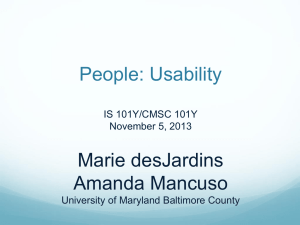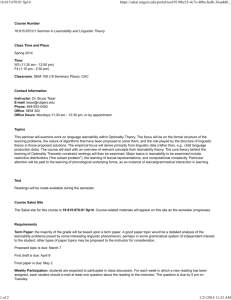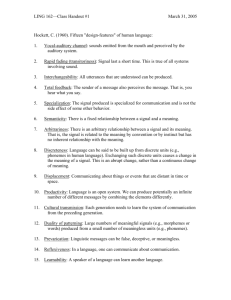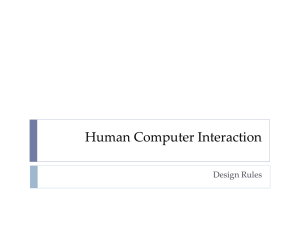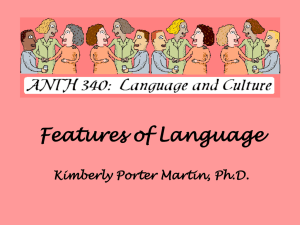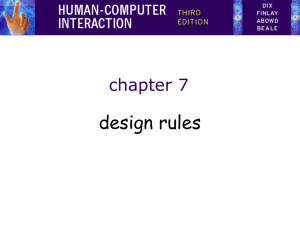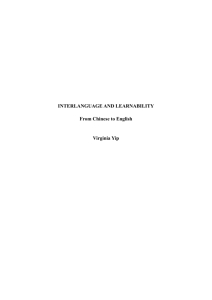A Survey of Software Learnability: Metrics, Methodologies and Guidelines
advertisement
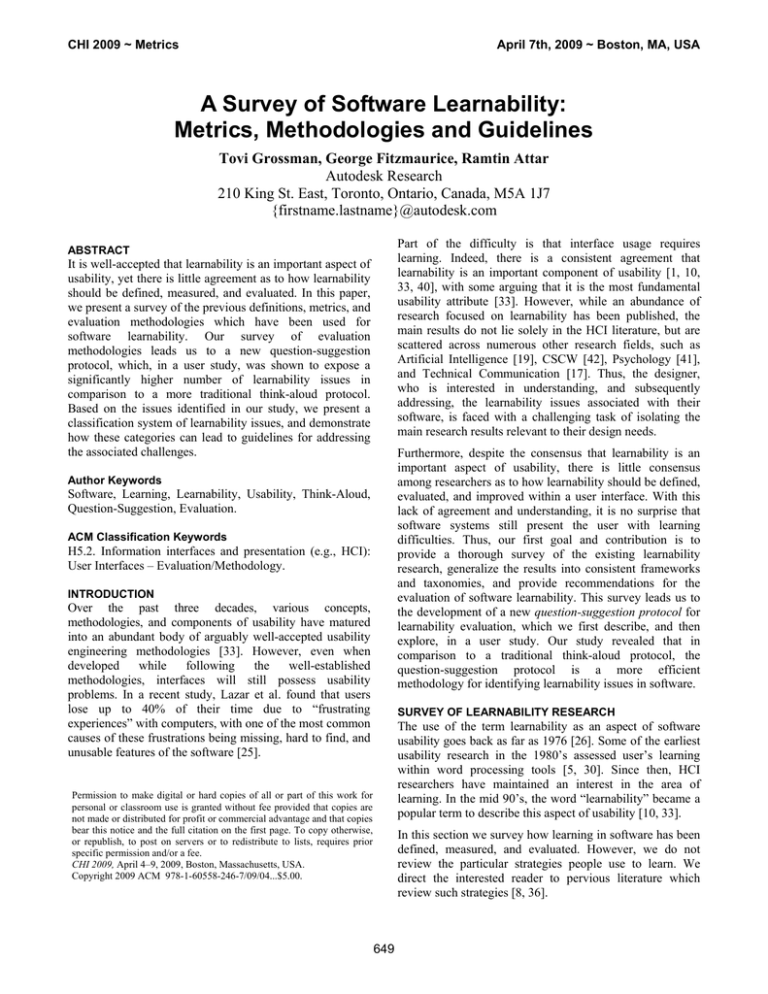
CHI 2009 ~ Metrics
April 7th, 2009 ~ Boston, MA, USA
A Survey of Software Learnability:
Metrics, Methodologies and Guidelines
Tovi Grossman, George Fitzmaurice, Ramtin Attar
Autodesk Research
210 King St. East, Toronto, Ontario, Canada, M5A 1J7
{firstname.lastname}@autodesk.com
Part of the difficulty is that interface usage requires
learning. Indeed, there is a consistent agreement that
learnability is an important component of usability [1, 10,
33, 40], with some arguing that it is the most fundamental
usability attribute [33]. However, while an abundance of
research focused on learnability has been published, the
main results do not lie solely in the HCI literature, but are
scattered across numerous other research fields, such as
Artificial Intelligence [19], CSCW [42], Psychology [41],
and Technical Communication [17]. Thus, the designer,
who is interested in understanding, and subsequently
addressing, the learnability issues associated with their
software, is faced with a challenging task of isolating the
main research results relevant to their design needs.
ABSTRACT
It is well-accepted that learnability is an important aspect of
usability, yet there is little agreement as to how learnability
should be defined, measured, and evaluated. In this paper,
we present a survey of the previous definitions, metrics, and
evaluation methodologies which have been used for
software learnability. Our survey of evaluation
methodologies leads us to a new question-suggestion
protocol, which, in a user study, was shown to expose a
significantly higher number of learnability issues in
comparison to a more traditional think-aloud protocol.
Based on the issues identified in our study, we present a
classification system of learnability issues, and demonstrate
how these categories can lead to guidelines for addressing
the associated challenges.
Furthermore, despite the consensus that learnability is an
important aspect of usability, there is little consensus
among researchers as to how learnability should be defined,
evaluated, and improved within a user interface. With this
lack of agreement and understanding, it is no surprise that
software systems still present the user with learning
difficulties. Thus, our first goal and contribution is to
provide a thorough survey of the existing learnability
research, generalize the results into consistent frameworks
and taxonomies, and provide recommendations for the
evaluation of software learnability. This survey leads us to
the development of a new question-suggestion protocol for
learnability evaluation, which we first describe, and then
explore, in a user study. Our study revealed that in
comparison to a traditional think-aloud protocol, the
question-suggestion protocol is a more efficient
methodology for identifying learnability issues in software.
Author Keywords
Software, Learning, Learnability, Usability, Think-Aloud,
Question-Suggestion, Evaluation.
ACM Classification Keywords
H5.2. Information interfaces and presentation (e.g., HCI):
User Interfaces – Evaluation/Methodology.
INTRODUCTION
Over the past three decades, various concepts,
methodologies, and components of usability have matured
into an abundant body of arguably well-accepted usability
engineering methodologies [33]. However, even when
developed
while
following
the
well-established
methodologies, interfaces will still possess usability
problems. In a recent study, Lazar et al. found that users
lose up to 40% of their time due to “frustrating
experiences” with computers, with one of the most common
causes of these frustrations being missing, hard to find, and
unusable features of the software [25].
SURVEY OF LEARNABILITY RESEARCH
The use of the term learnability as an aspect of software
usability goes back as far as 1976 [26]. Some of the earliest
usability research in the 1980’s assessed user’s learning
within word processing tools [5, 30]. Since then, HCI
researchers have maintained an interest in the area of
learning. In the mid 90’s, the word “learnability” became a
popular term to describe this aspect of usability [10, 33].
Permission to make digital or hard copies of all or part of this work for
personal or classroom use is granted without fee provided that copies are
not made or distributed for profit or commercial advantage and that copies
bear this notice and the full citation on the first page. To copy otherwise,
or republish, to post on servers or to redistribute to lists, requires prior
specific permission and/or a fee.
CHI 2009, April 4–9, 2009, Boston, Massachusetts, USA.
Copyright 2009 ACM 978-1-60558-246-7/09/04...$5.00.
In this section we survey how learning in software has been
defined, measured, and evaluated. However, we do not
review the particular strategies people use to learn. We
direct the interested reader to pervious literature which
review such strategies [8, 36].
649
CHI 2009 ~ Metrics
April 7th, 2009 ~ Boston, MA, USA
Learnability Definitions
Learning as a Function of Experience
Based on our literature review, the least agreed upon issue,
related to learnability, seems to be its definition. In 1980,
Michelsen et al. defined learnability as: “The system should
be easy to learn by the class of users for whom it is
intended” [32]. This definition epitomizes the difficulty
associated with defining learnability – what does it mean
for a system to be easy to learn? Here we review the context
which researchers over the past 25+ years have considered
learning within software, and then organize these
definitions into a unified framework.
A prevalent trend in the above definitions is that the type of
user, for which the learning occurs, is specified. For
example: “novice users” [33], “members of the user
community” [40], “typical user” [38], “new user” [10],
“with no formal training”, and “experienced users” [4].
While most of these terms usually delineate between a
novice or expert user group, Davis and Wiedenbeck present
another relevant type of user [9]. They define “subsequent
learning” as learning by a user whom is a novice to that
specific software system, but experienced with a similar
system. This suggests that the user will not only have the
required domain knowledge, but also a general
understanding of what tools and functions will be available.
Initial Learning
Nielsen defines learnability as a novice user’s experience of
the initial part of the learning curve [33], insisting that a
highly learnable system could be categorized as “allowing
users to reach a reasonable level of usage proficiency
within a short time”. While this definition indicates the
general idea of learnability, it is unclear what a “reasonable
level of proficiency” would be. Furthermore, it doesn’t
account for the learning that occurs after such a level has
been reached. While Nielsen does consider “efficiency of
use” as a separate aspect of usability, defined as the
performance level of an expert user, the transition from
“reasonable” to “expert” performance is not considered.
Learnability Usage in the HCI community
The above definitions give indication that there is no agreed
upon definition for learnability. Even those definitions
which only apply to initial learning, base their definitions
on differing assumptions about the user and what the
important measures are (i.e. errors, usage time, etc.).
To further strengthen our observation that the HCI
community has not adopted a single agreed upon definition
of learnability, we surveyed all articles published in CHI
and TOCHI, for which the term learnability occurred in the
body of the text. While there are many other HCI
publications which we could review, we felt restricting our
search to these two proceedings would be sufficient for
demonstrating that the definition of learnability is not
agreed upon.
Despite this potential shortcoming, defining learnability
based on initial user experiences is common. While less
specific, Shneiderman defines it similarly as “the time it
takes members of the user community to learn how to use
the commands relevant to a set of tasks” [40]. Santos and
Badre provide a similar definition, as “the effort required
for a typical user to be able to perform a set of tasks using
an interactive system with a predefined level of
proficiency” [38]. Alternatively, Holzinger defines
learnability as “allowing users to rapidly begin to work with
the system” [18]. Although all these definitions only
consider the initial learning experiences, they still all vary.
The survey resulted in a collection of 88 papers (76 from
CHI, 12 from TOCHI), dating from 1982 to 2008. We
organized the usage of “learnability” into 8 categories.
Some papers had definitions which fell into more than one
category, so the total number below exceeds 88.
•
•
•
•
•
•
•
•
Extended Learning
A more drastic difference is seen in definitions which
consider a larger scope of learning. Dix et al. provide a
definition which applies to both initial and long term
learning, stating it to be the “ease at which new users can
begin effective interaction and achieve maximal
performance” [10]. This is similar to Rieman’s definition:
“Minimally useful with no formal training, and should be
possible to master the software” [36]. Butler also considers
initial learnability and potential for efficiency, defining
learnability as both “Initial user performance based on selfinstruction” and “[allowing] experienced users to select an
alternate model that involved fewer screens or keystrokes”
[4]. A noticeable difference in Butler’s definition is that it
does not consider maximal performance, or “mastering” the
software, it simply requires there to be ways to increase
performance with experience. Bevan and Macleod provide
a similar, but more general definition, stating learnability to
be the “quality of use for users over time” [3].
Used without a definition: (45)
Generic learnability (i.e. “easy to learn”): (7)
Generic usability (i.e. “easy to use”): (3)
First time performance: (17)
First time performance after instructions: (4)
Change in performance over time: (8)
Ability to master system: (4)
Ability to remember skills over time: (2)
This survey again reiterates our belief that there is no wellaccepted definition of learnability.
Taxonomy of Learnability
Instead of declaring a correct definition from the prior
literature which we have reviewed, we have developed a
taxonomy of learnability to incorporate the most relevant
ideas into a single framework. We foresee this
organizational structure benefiting researchers and
evaluation practitioners, allowing them to isolate specific
areas of learnability which are of interest, and succinctly
convey their intentions.
650
CHI 2009 ~ Metrics
April 7th, 2009 ~ Boston, MA, USA
Learnability Scope
During an initial task
Perform well
Our review identified two main categories:
• Initial Learnability: Initial performance with the system.
• Extended Learnability: Change in performance over
time.
The ability to
Over specific interval
Over entire usage history
Specific performance
Eventually achieve
Learnability is based on:
Note that these categories can somewhat be thought of as
first and second order properties. Initial learnability applies
to the performance for a single usage period, while
extended learnability applies to the nature of performance
change over time.
Optimal performance
Experience with computers is
For a user
whose
Experience with interface is
[None … Optimal]
Domain knowledge is
Experience with similar software is
Figure 1. Taxonomy of learnability definitions
“Performance” itself could have a wide range of definitions,
such as completion times, error rates, or percentage of
functionality understood. We will discuss these measurable
“metrics” of learnability in the next section.
The need for such metrics is well motivated in both the
software engineering [15] and human-computer interaction
[4, 38] literature. From a software engineering perspective,
Gilb states that “We can’t possibly do adequate engineering
design when we work with design objectives stated in
ambiguous or abstract terms” [15]. From the HCI literature,
Butler comments “We need efficient, valid, and reliable
tools for measuring learnability” [4]. In an even stronger
statement, Santos and Badre state “despite the consensus
that learnability is an important issue in usability, few of
those authors discuss at length the issue of learnability
evaluation (a footnote states that they were tempted to
claim that none have discussed the issue at length) [38].
User Definition
A further distinction of learnability needs to be made based
on the assumptions of the user skills. For example, in initial
learnability, we would generally assume the user’s
experience with the user interface is very limited. However,
there are actually a number of relevant dimensions which
we should consider:
•
•
•
•
Improve performance
During an initial interval
Level of experience with computers
Level of experience with interface
Quality of domain knowledge
Experience with similar software
Our survey revealed that various metrics for learnability do
exist, but they are scattered across various research papers
over the last two decades. We were unable to find a single
collection of learnability metrics, similar to the published
collections of usability metrics (e.g. [10(p239), 33(p194),
40(p135)]. We have identified seven categories of metrics
which can be used for quantifying learnability (Table 1).
The first three dimensions we identify correspond to
Nielsen’s categorization of user experience [33]. We add a
fourth category to account for designers interested in
“subsequent learning” [9].
Taxonomy Examples
Since in the previous section we have defined a number of
dimensions upon which learnability can be considered, it is
important for us to outline how the presented metrics for
learnability apply to these various aspects of learnability. In
general, most of the metrics can be applied to any area of
the taxonomy. One important consideration, is whether the
metrics are based on a single time frame, and thus focused
on initial learnability, or an extended time frame, and thus
appropriate for extended learnability. However, in most
cases the metrics could be easily adapted such that the
relevant measure is maintained across both initial and
extended learnability. For example metric T4 could be used
for initial learnability by instead considering it as “number
of task errors during an initial task”.
We illustrate the full taxonomy in Figure 1. By using its
various dimensions, previous definitions can be transcribed.
For example, Nielsen’s definition “a novice user’s
experience of the initial part of the learning curve” [33],
would get translated to “The ability to perform well during
an initial interval.” Dix et al.’s compound definition “Ease
at which new users can begin effective interaction and
achieve maximal performance” [10], would be translated to
“The ability to perform well during an initial interval and
the ability to eventually achieve optimal performance, for a
user with no experience with the interface”. It should be
noted that for definitions which only consider initial
learnability, it is redundant to define the user’s experience
with the interface, since this experience level must be low.
Learnability Evaluation Methodologies
Learnability Metrics (operational definitions)
To use any of the metrics in Table 1, an evaluation needs to
be performed to capture their values. In the usability
engineering research literature, there are numerous
methodologies for assessing software usability. However it
is not clear which of these methodologies are most
appropriate for specifically focusing on software learnability.
Closely related to the definitions of learnability are the
metrics used to measure learnability. For example, if, based
on our above taxonomy, we are interested in initial
performance with the system, how do we go about
measuring this initial “performance”? Just as there is a lack
of consensus on the definition of learnability, there lacks a
set of well-accepted metrics for learnability.
651
CHI 2009 ~ Metrics
April 7th, 2009 ~ Boston, MA, USA
Rieman used a naturalistic learnability methodology, where
a diary was given to participants, who kept a record of all
learning related activities that occurred within a one week
time period [36]. Participants were then questioned about
their entries in a structured interview, and also asked about
learning activities outside of the one week time frame. This
methodology has the benefit of being performed in a real
usage setting, but it relies on the users having the ability to
identify the learnability issues which they encounter.
Task Metrics: Metrics based on task performance
T1. Percentage of users who complete a task optimally. [28]
T2. Percentage of users who complete a task without any help. [28]
T3. Ability to complete task optimally after certain time frame. [4]
T4. Decrease in task errors made over certain time interval. [32]
T5. Time until user completes a certain task successfully. [33]
T6. Time until user completes a set of tasks within a time frame. [33]
T7. Quality of work performed during a task, as scored by judges. [9]
Command Metrics: Metrics based on command usage
C1. Success rate of commands after being trained. [5]
C2. Increase in commands used over certain time interval. [32]
C3. Increase in complexity of commands over time interval. [32]
C4. Percent of commands known to user. [2]
C5. Percent of commands used by user. [2]
Another methodology of interest is the “coaching” or
“question-asking protocol”. This protocol was introduced
by Kato in 1986 [22], but, despite being referenced in
Nielsen’s Usability Engineering [33], has received little
attention from the HCI community. With this methodology,
an expert, or “coach” sits beside the participant, and
answers any questions that the participant may have during
use. This protocol was originally proposed as an alternative
to the think-aloud protocol, so that participants would be
encouraged to verbalize their thoughts.
Mental Metrics: Metrics based on cognitive processes
M1. Decrease in average think times over certain time interval. [32]
M2. Alpha vs. beta waves in EEG patterns during usage. [41]
M3. Change in chunk size over time. [38]
M4. Mental Model questionnaire pretest and post test results. [35]
Subjective Metrics: Metrics based on user feedback
S1. Number of learnability related user comments. [32]
S2. Learnability questionnaire responses. [12, 27]
S3. Twenty six Likert statements. [12]
Documentation Metrics: Metrics based on documentation usage
D1. Decrease in help commands used over certain time interval. [32]
D2. Time taken to review documentation until starting a task. [32]
D3. Time to complete a task after reviewing documentation. [32]
Mack and Robinson [29] summarize the work of Kato, and
state that “question asking … creates opportunities for users
to learn something about the system they are using”. So,
although the question-asking protocol was used for a
general usability study, it seems that this would be a perfect
methodology to use to identify learnability issues. Similar
protocols were proposed by Franzke, where hints which
were given to users were tracked and measured [14], and by
Dumas and Redish, who proposed counting calls to a
simulated help desk [11].
Usability Metrics: Metrics based on change in usability
U1. Comparing “quality of use” over time. [3]
U2. Comparing “usability” for novice and expert users. [3]
Rule Metrics: Metrics based on specific rules
R1. Number of rules required to describe the system. [19, 24]
Table 1. Categories of learnability metrics.
A main distinction for the type of usability evaluations
which can be performed is whether they are to be formative
or summative [33]. A formative evaluation is used to learn
about the usability problems associated with the system, in
an effort to improve the interface. A summative evaluation
is used to assess the overall usability of a system, in an
effort to either compare to another competing system, or to
determine if it meets requirements which have been set out.
This distinction can also be made for learnability
evaluations. Formative evaluations should expose
learnability issues, while summative evaluations should
provide an overall assessment of the system’s learnability.
In the following two sections we survey the methodologies
used to perform these two types of learnability evaluations.
Summative Learnability Evaluation Methodologies
In a follow-up to their initial think-aloud study, Carroll et
al. [5] augmented the think-aloud methodology with a
quantitative analysis of the user’s performance during the
test task, and time spent learning the documentation.
Davis and Wiedenbeck propose a different methodology for
assessing learnability [9]. As with the above methodology
users are given a fixed amount of time for training, and then
during a test task, users are left by themselves, with only
the system documentation to refer to as aid. The users are
given a fixed amount of time to complete the task, and the
evaluation is then based on the final product of their task, as
scored by judges. The judges scored a transcribed word
processor document. This methodology may provide a more
natural usage environment than the think-aloud protocol.
Formative Learnability Evaluation Methodologies
One of the most common forms of usability testing, the
think-aloud protocol [13], was originally used in the HCI
field to evaluate initial learnability. Mack et al. asked users
to verbalize as they worked, describing questions, plans,
strategies, inferences, and knowledge they were aware of
[30]. The protocol was performed both during a training
phase, where users studied the system documentation, and
during the performance of a test task. All comments were
recorded and the screen was captured by video, for postexperiment qualitative analysis. This methodology can be
useful for identifying learnability issues, but takes place in
the unnatural environment of a usability lab.
A more controlled method to obtain subjective learnability
feedback is demonstrated by Elliott et al. [12]. They
brought participants into a lab and had them complete a set
of given tasks, and gave the participants a survey of 25
learnability related questions. Butler [4] uses a similar
methodology, but also records the time to complete the
task. Of course, based on the desired information, most of
the metrics discussed in the previous section could be
recorded during this type of lab-based study.
652
CHI 2009 ~ Metrics
April 7th, 2009 ~ Boston, MA, USA
The above types of summative evaluations can be made by
using any subset of the metrics outlined in the previous
section, although the evaluator could choose specific
metrics that are most relevant to the product service or
success. For example, for software that depends on
consumers’ initial impressions, task metrics, capturing
initial learnability could be used, such as T2 or T5.
As such we suggest augmenting the question-asking
protocol [22] into a “question-suggestion” protocol, in
which the expert can also freely provide advice to the user.
This would replicate a scenario, where a user is performing
the task next to a colleague, and the colleague notices a
usage behavior which could be improved upon. This type of
informal, or “over the shoulder” learning has been shown to
be a common way for users to learn [31, 42]. Including
suggestions into the protocol would allow the system
evaluators to identify causes for suboptimal performance,
indicating barriers to extended learnability. Furthermore,
allowing a coach to provide suggestions may allow the user
to progress further through a task, which in turn could
expose a larger set of learnability issues. Thus, we believe
the question-suggestion protocol could be a suitable
methodology for learnability evaluation, since it captures
both the initial and extended learnability dimensions of our
taxonomy. By selecting appropriate users, the methodology
can also capture the user dimension of the taxonomy
(Figure 1).
Initial and Extended learnability evaluation methodologies
In relation to our taxonomy, the majority of the evaluation
methodologies which we reviewed were focused on initial
learnability. This is likely a reflection of the fact that in
general, evaluating initial learnability will be an easier task.
Nielsen states: “One simply picks some users who have not
used the system before and measures the time it takes them
to reach a specified level of proficiency in using it” [33].
Evaluating extended learnability is a more challenging task,
as it can require the assessment of performance over a long
period of time. To do this completely accurately the study
would need to follow a group of users of the desired period
of time, and potentially take years to complete.
USER STUDY
While previous work has explored the coaching protocol,
our literature review has not identified a previous study
testing the question-suggestion protocol which we have
described above. Furthermore, we are unaware of previous
work which has compared any such “coaching” protocol to
the traditional think-aloud protocol, to explore the relative
benefits of each, and the nature of the observations which
each will produce. In this study, we explore this potential
learnability evaluation methodology.
Bevan and Macleod suggest comparing usability for novice
and experienced users [3]. With a large enough sample size,
and an adequate range of user experience levels studied,
this type of study could reveal important information on
how user performance progresses over long periods of time.
Recent work has also looked at assessing user “expertise”
[20, 37]. Such a metric could be used when comparing
users at various experience levels, to get a sense of the
progression of performance over time. However, a potential
problem with this methodology is that the result may be
misleading, in that they would reveal a continuous
progression of performance improvement over time, where
for each individual user this progression could be extremely
discrete, with major learning events occurring periodically.
To perform the study we needed a software application
which would be complex enough to possess numerous
learnability challenges, and also a system for which we
would have access to a system expert that could serve as a
coach. For the purpose of the evaluation, we chose the
popular computer-aided design system, AutoCAD.
THE QUESTION-SUGGESTION PROTOCOL
Many of the methodologies discussed in our survey take on
the same form as traditional usability studies. If the goal of
the study is to identify learnability issues which can be
addressed, it is not clear if using traditional usability
methodologies is the right approach, since they may not be
designed to specifically expose learnability problems.
Participants
Ten volunteers (7 male, 3 female) participated in the
experiment. Participants were university architecture
undergraduate students, aged 19-30. Participants were
chosen with usage experiences ranging from two months to
five years. We decided it would be inappropriate to seek
users with no AutoCAD experience, since the software is
not meant to be walk-up and use. Referring to our
taxonomy, it would be inappropriate to base the learnability
of AutoCAD on an “initial interval” or “initial task”.
Further, architecture students would have the quality of
domain knowledge which would be required to successfully
complete tasks with AutoCAD. We did not control for the
participants’ experience level with similar software
We identified the coaching protocol as a particularly
interesting methodology which may be suitable for
highlighting learnability issues. That is, the dialogue which
occurs between the user and coach will identify areas of the
system which present learnability challenges.
However, as with the other discussed methodologies, the
coaching methodology is focused on initial learnability, as
the user is only coached when they are stuck with the
interface. To truly understand extended learnability, we
must also understand what causes users to not just acquire
new abilities, but what causes them to improve their usage
behaviors by finding more efficient strategies.
The Coach
We recruited a single AutoCAD expert to act as the coach.
The coach was a professional architect with 12 years of
experience using AutoCAD, and had taught AutoCAD at
the university level for 4 years.
653
CHI 2009 ~ Metrics
April 7th, 2009 ~ Boston, MA, USA
Setup
Think-Aloud Protocol Instructions to Participant:
1.
Try to verbalize all of your actions, intentions and thoughts
during the study. I will give you an example.
2.
Focus on getting the task done, as you would in the real world.
3.
You may be asked to do things you’ve never done before, or
don’t know how to do. Try to do your best to figure out how to
accomplish these tasks, as if you were at home by yourself.
You may use help systems, online searches, or any other
resources that you would normally use.
4.
The coach is only here to make observations, he will clarify any
aspects of the tasks, but you cannot ask him how to accomplish
the task.
Think-Aloud Protocol Instructions to Coach:
1.
If the user is frustratingly stuck, provide specific procedural
suggestions, to get the experiment moving again.
2.
Do not tutor, or explain at length.
Question-suggestion Protocol Instructions to Participant:
1.
Ask relatively specific, procedural questions.
2.
Try to answer your own questions first, but do not engage in
extensive problem solving.
3.
Focus on getting the task done, as you would in the real world.
Question-suggestion Protocol Instructions to coach
1.
Reply with specific procedural answers, to the underlying form
of the question.
2.
Do not tutor, or explain at length.
3.
Maintain focus on the task, even when providing suggestions.
4.
Provide suggestions if you notice inefficient usage behaviors,
and if the suggestions would likely be welcomed and beneficial
to the user.
The study took place in a usability lab. The participant sat
at a standard PC workstation. The screen video was
captured directly and audio was captured through an
external microphone. Each subject experienced a thinkaloud protocol and a question-suggestion protocol while
being given a series of real-world AutoCAD tasks to
perform. In the think-aloud sessions, the “coach” sat further
away from the participant, at a table where they could still
observe the user’s actions, and in the question-suggestion
sessions the coach sat beside the participant. We found in a
pilot study that this helped the user differentiate between
the two protocols, so they would not ask for help in the
think-aloud protocol sessions.
In addition to the coach, an experimenter sat in the room to
explain the study and procedure to the participant. The
experimenter was an HCI researcher. The presence of the
experimenter was necessary to ensure the study protocols
and procedures were being followed correctly, as the coach
did not have experience with performing usability studies.
Task Scenarios and Procedure
During the design of the study, the coach generated 4
different real-world task scenarios for use in the studies,
and template data for use during these sessions. The task
scenarios were purposely made to be high-level, requiring
numerous steps to be carried out, in potentially a number of
different ways, covering a wide range of the application’s
functionality. The tasks were generated to be at a moderate
level of difficulty, so that it would not be too difficult for
the most novice users, and not too easy for the most
experienced participants. Our hope was that these scenarios
would expose both cases where users did not know
immediately how to complete the task (exposing initial
learnability issues), and where users knew of a way to
complete the task, but not necessarily an accurate or
efficient way (exposing extended learnability issues).
Table 2. Protocol instructions for the participant and coach.
Design
A mixed factorial design was used for the study, with the
within subject variable being the evaluation protocol (thinkaloud, question-suggestion), and the between subject
variable being experience (ranging from 2 months to 5
years experience). Although we didn’t preemptively control
for experience level, it turned out that we could group user
experience at four different levels: 2 months (2 users), 1.5
years (2 users), 2 years (2 users) and 5 years (4 users). The
order of the protocols was counterbalanced, with half of the
participants performing each protocol first. The tasks were
completed in the same order for each participant.
The experiment occurred in two 30 minute sessions, one
under the think-aloud protocol, and one under the questionsuggestion protocol. Table 2 shows the instructions given to
the participant and coach for the two sessions. In the
question-suggestion protocol, the coach was instructed to
only provide suggestions when he felt it would provide an
immediate benefit and be welcomed by the user.
Results
Observed Learnability Issues
Similar to previous work comparing evaluation
methodologies [21], our main dependant variable of interest
was the number of problems discovered, specifically
learnability issues. Although there are issues with relying
on “problems detected” for comparing methodologies [43],
we felt it to be most appropriate for our purposes.
Along with the instructions provided in Table 2, users were
asked to complete the tasks as accurately as they would in a
real-world scenario, as if it were an ongoing project that
they would be using in the future. Users were also told they
could ask task clarification questions at any time, regardless
of the protocol currently in use.
Learnability issues were recorded by the experimenter, and
not the coach. We felt that allowing the coach to record
learnability issues would possibly distract him from
properly performing the evaluation protocols. Furthermore,
allowing the coach to record learnability issues would be
slightly misleading, since most often such skilled software
experts are not present during think-aloud usability studies.
Once the instructions were given, users were given one task
scenario at a time to complete, each lasting at most 15
minutes. Two tasks were performed in each session. The
user was asked to proceed to the next task if not finished
after 15 minutes, or to stop working if they had not
completed a task at the end of a 30-minute session.
In most cases, we could rely on the dialogue to identify
learnability issues. However, in some cases, users were
654
CHI 2009 ~ Metrics
April 7th, 2009 ~ Boston, MA, USA
• Understanding Functionality. This problem means that
users were aware of a single, specific, tool or function,
able to locate it, but could not figure out how to use it.
• Transitioning to Efficient Behaviors. This issue is more
specific to extended learnability. It indicates the user was
aware of certain functionality, but chose not to use it.
clearly having difficulties learning to use an aspect of the
system without verbalizing those difficulties (even in the
think-aloud protocol). Such events were also recorded as
learnability issues. For the dialogue, the experimenter
judged whether or not the user’s or coach’s utterances were
a result of a learnability issue. If this was deemed to be the
case, the learnability issue would be recorded.
Number of Issues Idenfied
12
10
Category
Queson Suggeson
Task Flow
Think Aloud
Awareness
8
Locating
6
Understanding
4
Transition
2
Example Learnability Issue Observed
Did not know how to set up a text style.
Did not know how to evenly space 6 objects.
Was not aware of the divide command.
Was not aware of the mirror command.
Could not find layer manager icon.
Could not find leader toolbar.
Couldn’t figure out how to use the extend command.
Couldn’t figure out how to use the align command.
Did not use match properties tool and instead
created a new hatch.
Didn’t think to use mirror command, and instead
manually created a section of a plan.
Table 3. Categories of observed learnability issues.
0
2 Months
1.5 Years
2 Years
In Figure 3, we outline the relative proportions of these
categories that each of the protocols exposed. It can be
observed that the think-aloud protocol identified a higher
proportion of locating issues, while exposing a smaller
proportion of awareness issues and no transition issues.
This is a result of how think-aloud protocols are performed.
It is more difficult to identify awareness and transition
issues, since it is unlikely the user would verbalize these
issues, and they may not expose any identifiable behavior
indicating that they are having difficulties. These types of
problems are identifiable in the question-suggestion
protocol, highlighted when the coach gives the user an
associated suggestion (e.g. “Did you know that you could
use a divide command”, or “why don’t you use the match
properties tool instead, it will save you time and effort”).
5 Years
Experience Level
Figure 2. Average number of learnability issues identified by
protocol, measured over each 15 minute task.
A repeated measure analysis of variance, on the number of
learnability issues which occurred per 15 minute task,
showed significant main effect for Protocol (F1,6 = 48.8,
p < 0.001) and Experience (F3,6 = 5.12, p < 0.05). The
average number of learnability issues reported were 2.8 for
the think-aloud protocol and 7.55 for the questionsuggestion protocol. This is an important result, as it shows
that the question-suggestion protocol accomplished exactly
what we had hoped, as more learnability issues were
identified.
For both protocols, the number of learnability issues
reported decreased as the user experience level increased
(Figure 2). The interaction between Protocol and
Experience was not significant. This was surprising, as one
could expect that the difference between the two protocols
may depend on the experience level of the users.
Task Flow
Think
Aloud
Awareness
Locang
Understanding
Queson
Suggeson
Transion
Categorization of Learnability Issues
0%
From the collection of learnability issues which were
identified, we were able to identify and categorize specific
types of problems which occurred (Table 3). The
categorization that we decided upon is as follows:
20%
40%
60%
80% 100%
Figure 3. Proportion of issues observed by category.
Figure 4 shows the average number of problems identified
in each category, as a function of the user’s experience
level. The most prominent and divergent effect here is that
Awareness was a major issue for the most novice users, and
that Task Flow was rarely a problem for the expert users.
This indicates that the experienced users had a sound
understanding of the general method used to accomplish
high level tasks, even if they may not have known exactly
how to accomplish it, step by step. It can also be observed
that no transition issues were experienced by the most
novice level of users. This is consistent with the questionsuggestion protocol instructions, which were given to the
coach, since suggestions about transitioning to expert
• Understanding Task Flow. Often it was clear to the user
that a series of operations would be required to complete
a certain aspect of their task, but they did not know
where to start, or the high-level task flow to follow.
• Awareness of Functionality. Another typical problem
was that users were not aware of a specific tool or
operation which was available for use.
• Locating Functionality. This problem occurred when the
user was aware of a certain operation which the system
possessed, but could not figure out where to find it in the
user interface, so that it could be utilized.
655
CHI 2009 ~ Metrics
April 7th, 2009 ~ Boston, MA, USA
Task Flow
Number of Issues Idenfied
behaviours would likely have been more of a hinderence at
the novice’s early usage stage. Refering back to our
taxonomy, Figure 4 also indicates that each learnability
category can expose issues related to both initial and
extended learnability. The one exception is the Transition
category, which would mostly expose issues related to
extended learnability.
2.5
Improving a user’s understanding of task flow may be one
of the most difficult challenges to address. Even with a shift
towards task-based documentation [6], the queries a user
would enter are still generally low level tasks. For example,
in an image editor, one may search for “create a new brush
style”, but it is unlikely they would find help if they
searched for “create a texture that looks like a hardwood
floor”. Allowing users to locate such higher level task flows
is a potential guideline which could be investigated.
2 Months
1.5 Years
2
2 Years
1.5
Awareness
5 Years
The graphical user interface is an excellent way of making
functionality visible to the user, and thus improving their
awareness through visual exposure [39]. However, in a
command rich interface, it is impossible for a user to be
aware of everything. There are some interesting areas to
explore for addressing this design guideline. Previous
efforts to implement intelligent agents, such as Microsoft’s
“Clippy”, which present relevant information to the user,
have failed [44]. However, we do not believe the problem is
unsolvable. There is still room to explore strategies for
making such suggestions less intrusive, and more semantic,
so that users are gradually made aware of information
which is likely to be useful. For example, Grossman et al.
showed that by presenting an audio hint for a hotkey when
a user selected an associated menu item, users were more
likely to transition to this more expert behavior [16].
1
0.5
0
Task Flow Awareness
Locang Understand Transion
Category
Figure 4. Identified categories by experience level
Questionnaire Results
After the experiment we administered a questionnaire,
asking the participants about their opinions of the two
evaluation protocols. The questionnaire consisted of 6
questions on a 5-point Likert Scale, for each of the
protocols. The results were analyzed using a paired t-test.
The protocol had a significant effect on three responses.
First, the response to the user’s ability to progress quickly
through the task was more positive for the questionsuggestion protocol (t9 = 2.60, p < .05). This is an important
result, as it shows that users were able to accomplish more
in the question-suggestion protocol. This is one reason the
protocol was able to identify more learnability issues.
Locating
The typical approach to aiding the user’s ability to locate
functionality is to provide online documentation. Recently,
stencil-based tutorials, which illustrate directly on the user
interface, were shown to be an effective way of identifying
the location of functionality [23]. This form of contextual
aid is extremely important for applications with
customizable UI views. In our study, we observed, on
numerous occasions, users disabling and immediately reenabling toolbars so they could locate them on the screen
layout. Thus, a potential design guideline which addresses
locating is to make system documentation sensitive to the
user’s current UI layout.
Second, the response to getting frustrated during the
evaluation was lower for the question-suggestion protocol
(t9 = 2.63, p < .05). Although this was not the intention of
the new protocol, it is a beneficial side-effect.
And third, the response to learning new things was more
positive for the question-suggestion protocol (t9 = 2.45,
p < .05). This indicates that the coach was successfully
giving useful suggestions to the users, and not simply
stating redundant information.
Understanding
As with locating functionality, help systems are often the
method of choice for improving the understanding of how
to use functionality. However, complex operations can be
difficult to describe to the user, without providing an actual
demonstration. As evidence, the coach in our study
mentioned that on numerous occasions he wished he could
drive the application for the user, since it would convey the
ideas much more efficiently than trying to describe them.
Two relevant guidelines can be taken from this. First, is to
explore help systems which guide by demonstration, in the
context of the user’s own interface. Second, is to enrich
documentation with multimedia content [34], so that
complex operations can be clearly demonstrated to the user.
GUIDELINES FOR INTERFACE LEARNABILITY
A potential implication of identifying the above-mentioned
learnability categories is that design guidelines for
improving learnability which isolate these specific
categories can be developed. Although our categorization is
based on a study with a single specific software application,
we believe the identified categories can be generalized to
other software applications. In this section, we discuss
example guidelines for addressing each of the identified
categories. These are not meant to be exhaustive; they only
exemplify how our categorization has the potential to
identify future research directions.
656
CHI 2009 ~ Metrics
April 7th, 2009 ~ Boston, MA, USA
Transitions
may not recognize. Thus, having an expert present allows
the evaluator to identify extended learnability issues, which
would otherwise be ignored. This exposes an advantage in
comparison to not just the think-aloud protocol which we
compared to, but the other formative methodologies which
we reviewed. Thus, we feel the study would provide similar
results if we had compared to other methodologies. This
indicates that other protocols could be explored which rely
on the presence of an expert.
It is fairly well understood that user performance plateaus at
a suboptimal level of performance [8, 33]. Researchers have
proposed training wheel interfaces, so that advanced
functionality is gradually exposed to users [7], however, in
many cases users are fully aware of the existence of
functionality which can help them, and do not use it [8].
Recently, it was proposed that software systems could
increase the user’s motivation to transition to efficient
behaviors [16]. This is a design guideline that provides an
interesting new space to explore. It is likely that users
perform a mental “cost benefit” analysis before deciding to
try new functionality. We need to better understand and
attempt to model this calculation that users perform, and
then seek design strategies for biasing the decision towards
what would be the optimal behavior.
We also feel that there is room for the development of more
elegant metrics which measure learnability. The metrics
which have been developed to date are generally measured
during specific tasks and thus cannot be generalized or
compared to other tasks or user interfaces. For example,
there are no generalized metrics which would allow a
designer to determine if their interface, overall, increases
learnability, in comparison to another. Efforts in developing
such “universal” usability metrics have been conducted
[27], and similar efforts could be made towards learnability.
DISCUSSION AND FUTURE WORK
In the first part of this paper we presented a survey of
software learnability. It is important to clarify that our
literature review, including the development of the
taxonomy, was based on a review of research relating to the
underlying concept of learning in software, and not strictly
on the term “learnability”. We did find that the majority of
papers which label the higher level concept with a single
term do use the word “learnability” which is why we have
used this term throughout the paper. While our taxonomy is
mostly aimed at researchers, future work could translate the
taxonomy into a formal specification based language, which
could increase its practical importance.
CONCLUSIONS
In conclusion, we have performed an investigation into the
issues relating to the learnability of software applications. A
significant contribution of our work is the collection of
these results into a survey of definitions, metrics, and
methodologies used to evaluate learnability. We also
developed a new question-suggestion evaluation protocol to
specifically identify existing learnability issues in an
application, and compared it to a traditional think-aloud
evaluation. Not only did this study show that our new
methodology exposed a significantly larger number of
learnability issues, it also allowed us to collect and
categorize learnability issues. We believe that there is still
room for refinements to the evaluation process of software
learnability and a vast design space which remains to be
explored for improving learnability. Our hope is that the
current work will serve as a resource and inspiration for
future research in these areas.
In the second part of the paper we investigated a new
question-suggestion evaluation protocol, which was shown
to have benefits in comparison to the more traditional thinkaloud protocol. The results should be treated with caution,
since this was an initial study with only ten participants,
and the learning issues were identified by the experimenter
without external validation. Our intention is not to find a
replacement to think-aloud, or even to proclaim that the
question-suggestion protocol is a “better” protocol to be
used for usability evaluations. The think-aloud protocol has
some important benefits which make it appropriate for
certain types of studies. For one, the think-aloud protocol
does not require the presence of a software expert, as the
question-suggestion protocol does, which could add
complications to performing a study. Furthermore, thinkaloud studies allow observers to see how well users can
recover from errors, and how long it takes them to figure
things out on their own. These issues are important to
understand before software is released, and the questionsuggestion protocol does not provide such information.
Finally, the suggestions provided in the question-suggestion
protocol accelerate the natural learning process, and so the
study is not representative of natural software usage.
ACKNOWLEDGEMENTS
We would like to thank the CHI reviewers who provided
particularly thorough reviews and thoughtful suggestions,
which were incorporated into the final version of this paper.
REFERENCES
1. Abran, A., Khelifi, A., Suryn, W. and Seffah, A. (2003).
Usability Meanings and Interpretations in ISO
standards. Software Quality Journal. 11:325-338.
2. Baecker, R., Booth, K., Jovicic, S., McGrenere, J. and
Moore, G. (2000). Reducing the gap between what users
know and what they need to know. Proceedings on the
2000 conference on Universal Usability. 17-23.
3. Bevan, N. and Macleod, M. (1994). Usability
measurement in context. Behaviour and Information
Technology. 13:132-145.
4. Butler, K. A. (1985). Connecting theory and practice: a
case study of achieving usability goals. ACM CHI. 85-88.
One of the main benefits of the question-suggestion
protocol was the presence of a software expert, who acted
as the coach. The expert was able to identify inadequate
behavior, which an evaluator less educated in the system
657
CHI 2009 ~ Metrics
April 7th, 2009 ~ Boston, MA, USA
5. Carroll, J., Mack, R., Lewis, C., Grischkowsky, N. and
Robertson, S. (1985). Exploring exploring a word
processor. Human-Computer Inter. 1:283-307.
6. Carroll, J. M. (1990). The Nurnberg Funnel. MIT Press.
7. Carroll, J. M. and Carrithers, C. (1984). Training wheels
in a user interface. Comm. ACM. 27(8):800-806.
8. Carroll, J. M. and Rosson, M. B. (1987). Paradox of the
active user. Interfacing thought: cognitive aspects of
human-computer interaction. MIT Press. 80-111.
9. Davis, S. and Wiedenbeck, S. (1998). The effect of
interaction style and training method on end user
learning of software packages. Interacting with
Computers. 11(2):147-172.
10. Dix, A., Finlay, J. E., Abowd, G. D. and Beale, R.
(2003). Human Computer Interaction. Prentice-Hall.
11. Dumas, J. F. and Redish, J. C. (1993). A Practical Guide
to Usability Testing. Greenwood Publishing Group Inc.
12. Elliott, G. J., Jones, E. and Barker, P. (2002). A
grounded theory approach to modeling learnability of
hypermedia authoring tools. Interacting with
Computers. 14(5):547-574.
13. Ericsson, K. A. and Simon, H. A. (1984). Protocol
Analysis: Verbal Reports as Data. MIT Press.
14. Franzke, M. (1995). Turning research into practice:
characteristics of display-based interaction. ACM CHI.
421–428.
15. Gilb, T. (1996). Level 6: Why we can't get there from
here. IEEE Software. 13(1):97-98, 103.
16. Grossman, T., Dragicevic, P. and Balakrishnan, R.
(2007). Strategies for accelerating on-line learning of
hotkeys. ACM CHI. 1591-1600.
17. Haramundanis, K. (2001). Learnability in information
design. ACM SIGDOC. 7-11.
18. Holzinger, A. (2005). Usability engineering methods for
software developers. Comm. of ACM. 48(1):71-74.
19. Howes, A. and Young, R. M. (1991). Predicting the
learnability of task-action mappings. ACM CHI. 12041209.
20. Hurst, A., Hudson, S. E. and Mankoff, J. (2007).
Dynamic detection of novice vs. skilled use without a
task model. ACM CHI. 271-280.
21. Jeffries, R., Miller, J. R., Wharton, C. and Uyeda, K.
(1991). User interface evaluation in the real world: a
comparison of four techniques. ACM CHI. 119-124.
22. Kato, T. (1986). What question-asking protocols can say
about the user interface. Int. J. Man-Mach. Stud.
25(6):659-673.
23. Kelleher, C. and Pausch, R. (2005). Stencils-based
tutorials: design and evaluation. ACM CHI. 541-550.
24. Kieras, D. E. and Polson, P. G. (1985). An approach to
the formal analysis of user complexity. International
Journal of Man-Machine Studies. 22:365-394.
25. Lazar, J., Jones, A. and Shneiderman, B. (2006).
Workplace user frustration with computers: An
exploratory investigation of the causes and severity.
Behaviour and Info. Technology. 25(3):239-251.
26. Licklider, J. C. R. (1976). User-oriented interactive
computer graphics. ACM UODIGS. 89-96.
27. Lin, H. X., Choong, Y. and Salvendy, G. (1997). A
proposed index of usability: a method for comparing the
relative usability of different software systems.
Behaviour & Information Technology. 16:267-278.
28. Linja-aho, M. (2005). Evaluating and Improving the
Learnability of a Building Modeling System. Helsinki
University of Technology.
29. Mack, R. and Robinson, J. B. (1992). When novices
elicit knowledge: question asking in designing,
evaluating, and learning to use software. The psychology
of expertise: cognitive research and empirical AI.
Springer-Verlag, Inc. p. 245-268.
30. Mack, R. L., Lewis, C. H. and Carroll, J. M. (1983).
Learning to use word processors: problems and
prospects. ACM Trans. Inf. Syst. 1(3):254-271.
31. Mackay, W. E. (1991). Triggers and barriers to
customizing software. ACM CHI. 153-160.
32. Michelsen, C. D., Dominick, W. D. and Urban, J. E.
(1980). A methodology for the objective evaluation of
the user/system interfaces of the MADAM system using
software engineering principles. ACM Southeast
Regional Conference. 103-109.
33. Nielsen, J. (1994). Usability Engineering. Morgan
Kaufmann.
34. Palmiter, S. and Elkerton, J. (1991). An evaluation of
animated demonstrations of learning computer-based
tasks. ACM CHI. 257-263.
35. Paymans, T. F., Lindenberg, J. and Neerincx, M. (2004).
Usability trade-offs for adaptive user interfaces: ease of
use and learnability. ACM IUI. 301-303.
36. Rieman, J. (1996). A field study of exploratory learning
strategies. ACM TOCHI. 3(3):189-218.
37. Santos, P. J. and Badre, A. N. (1994). Automatic chunk
detection in human-computer interaction. AVI. 69-77.
38. Santos, P. J. and Badre, A. N. (1995). Discount
learnability evaluation. GVU Technical Report GITGVU-95-30. Georgia Institute of Technology.
39. Shneiderman, B. (1983). Direct Manipulation: A Step
Beyond Programming Languages. Comp. 16(8):57-69.
40. Shneiderman, B. (1997). Designing the User Interface:
Strategies for Effective Human-Computer Interaction.
Addison-Wesley Longman Publishing Co., Inc.
41. Stickel, C., Fink, J. and Holzinger, A. (2007).
Enhancing Universal Access–EEG Based Learnability
Assessment. Lecture Notes in Comp. Sci. 813-822.
42. Twidale, M. B. (2005). Over the Shoulder Learning:
Supporting Brief Informal Learning. CSCW. 14(6):505547.
43. Wixon, D. (2003). Evaluating usability methods: why
the current literature fails the practitioner. Interactions.
10(4):28-34.
44. Xiao, J., Stasko, J. and Catrambone, R. (2004). An
empirical study of the effect of agent competence on
user performance and perception. Autonomous Agents
and Multiagent Systems - Volume 1. 178-185.
658
